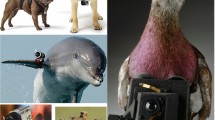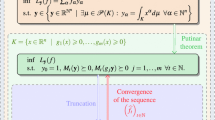Abstract
Geometric relationships governing multiple images of points and lines and associated algorithms have been studied to a large extent separately in multiple-view geometry. The previous studies led to a characterization based on multilinear constraints, which have been extensively used for structure and motion recovery, feature matching and image transfer. In this paper we present a universal rank condition on the so-called multiple-view matrix M for arbitrarily combined point and line features across multiple views. The condition gives rise to a complete set of constraints among multiple images. All previously known multilinear constraints become simple instantiations of the new condition. In particular, the relationship between bilinear, trilinear and quadrilinear constraints can be clearly revealed from this new approach. The theory enables us to carry out global geometric analysis for multiple images, as well as systematically characterize all degenerate configurations, without breaking image sequence into pairwise or triple-wise sets of views. This global treatment allows us to utilize all incidence conditions governing all features in all images simultaneously for a consistent recovery of motion and structure from multiple views. In particular, a rank-based multiple-view factorization algorithm for motion and structure recovery is derived from the rank condition. Simulation results are presented to validate the multiple-view matrix based approach.
Similar content being viewed by others
References
Avidan, S. and Shashua, A. 1998. Novel view synthesis by cascading trilinear tensors. IEEE Transactions on Visualization and Computer Graphics (TVCG), 4(4).
Faugeras, O., Luong, Q.-T., and Papadopoulo, T. 2001. Geometry of Multiple Images. The MIT Press.
Faugeras, O. and Mourrain, B. 1995. On the geometry and algebra of the point and line correspondences between N images. In Proceedings of Fifth International Conference on Computer Vision, IEEE Comput. Soc. Press: Cambridge, MA, USA, pp. 951–956.
Hartley, R. 1994. Lines and points in three views—a unified approach. In Proceedings of 1994 Image Understanding Workshop, OMNIPRESS: Monterey, CA, USA, pp. 1006–1016.
Hartley, R. and Zisserman, A. 2000. Multiple ViewGeometry in Computer Vision. Cambridge.
Heyden, A. and Åström, K. 1997. Algebraic properties of multilinear constraints. Mathematical Methods in Applied Sciences, 20(13):1135–1162.
Kahl, F. and Heyden, A. 1999. Affine structure and motion from points, lines and conics. International Journal of Computer Vision, 33(3):163–180.
Kosecka, J. and Ma, Y. 2002. Introduction to multiview rank conditions and their applications: A review. Tyrrhenian International Workshop on Digital Communications (IWDC 2002).
Kruppa, E. 1913. Zur ermittlung eines objecktes aus zwei perspektiven mit innerer orientierung. Sitz.-Ber. Akad. Wiss., Math. Naturw., Kl. Abt. IIa, 122:1939–1948.
Liu, Y., Huang, T., and Faugeras, O. 1990. Determination of camera location from 2-D to 3-D line and point correspondences. IEEE Transactions on PAMI, 28–37.
Longuet-Higgins, H.C. 1981. A computer algorithm for reconstructing a scene from two projections. Nature, 293:133–135.
Ma, Y., Huang, K., Vidal, R., Koaecká, J., and Sastry, S. 2001. Rank conditions of multiple-view matrix in multiple view geometry. UIUC, CSL Technical Report, UILU-ENG 01-2214 (DC-220), June 18.
Ma, Y., Soatto, S., Koaecká, J., and Sastry, S. 2003. An Invitation to 3-D Vision: From Images to Geometric Models. Interdisciplinary Applied Mathematics. Springer-Verlag.
Fossum, R., Huang, K., Ma, Y. 2001. General rank conditions in multiple view geometry. UIUC, CSL Technical Report, UILUENG 01-2222 (DC-203).
Quan, L. and Kanade, T. 1996. A factorization method for affine structure from line correspondences. In Proceedings of the CVPR, pp. 803–808.
Shashua, A. 1994. Trilinearity in visual recognition by alignment. In Proceedings of ECCV, Vol. I, Springer-Verlag, pp. 479–484.
Shashua, A. and Wolf, L. 2000. On the structure and properties of the quadrifocal tensor. In Proceedings of ECCV, Vol. I, Springer-Verlag, pp. 711–724.
Spetsakis, M. and Aloimonos, Y. 1990. Structure from motion using line correspondences. International Journal of Computer Vision, 4(3):171–184.
Taylor, C.J. and Kriegman, D. 1995. Structure and motion from line segments in multiple images. IEEE Transactions of Pattern Analysis and Machine Intelligence, 17(11).
Tomasi, C. and Kanade, T. 1992. Shape and motion from image streams under orthography. Intl. Journal of Computer Vision, 9(2):137–154.
Triggs, B. 1995. Matching constraints and the joint image. In Proceedings of Fifth International Conference on Computer Vision, IEEE Comput. Soc. Press: Cambridge, MA, USA, pp. 338–343
Triggs, B. 1996. Factorization methods for projective structure and motion. In Proceedings of 1996 Computer Society Conference on Computer Vision and Pattern Recognition, IEEE Comput. Soc. Press: San Francisco, CA, USA, pp. 845–851.
Author information
Authors and Affiliations
Rights and permissions
About this article
Cite this article
Ma, Y., Huang, K., Vidal, R. et al. Rank Conditions on the Multiple-View Matrix. International Journal of Computer Vision 59, 115–137 (2004). https://doi.org/10.1023/B:VISI.0000022286.53224.3d
Issue Date:
DOI: https://doi.org/10.1023/B:VISI.0000022286.53224.3d




